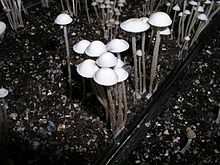|
Panaeolus cambodginiensis
Panaeolus cambodginiensis is a potent hallucinogenic mushroom that contains psilocybin and psilocin. It was described in 1979 as Copelandia cambodginiensis.[1] DescriptionThe cap is less than 23 mm across, with a convex shape and an incurved margin when young, expanding to broadly convex. The cap surface is smooth, often cracking with irregular fissures. The gills are gray to black. The stem is 5 to 10 centimetres (2.0 to 3.9 in) tall, 4 mm thick, and slightly swollen at the base. The spores are black, shaped like lemons, smooth, measuring 11 x 8 μm. The entire mushroom quickly bruises blue where it is handled. It can be differentiated from the similar Panaeolus cyanescens by microscopic characteristics. Distribution and habitatPanaeolus cambodginiensis is mushroom that grows on dung of water buffalo. It was first described from Cambodia and is widespread throughout the Asian subtropics and Hawaii. Alkaloid contentStrongly bluing species. Merlin and Allen (1993) reported the presence of psilocybin and psilocin, up to .55% and .6%, respectively.[2] See alsoReferences
External links |
||||||||||||||||||||||||||||||||||||||||||||||
